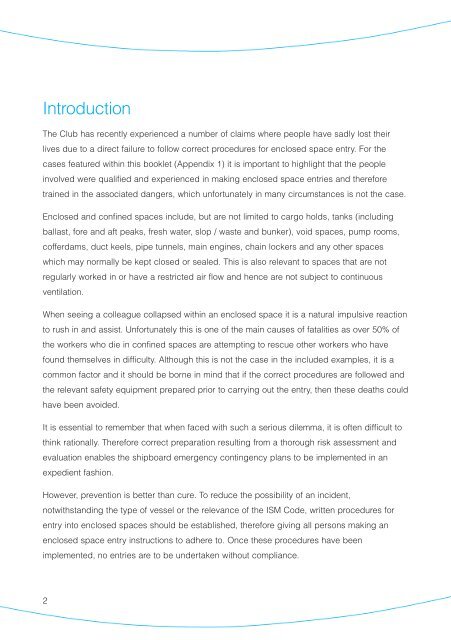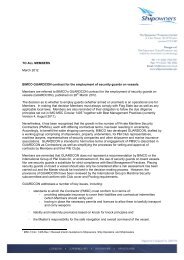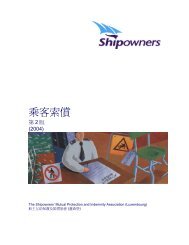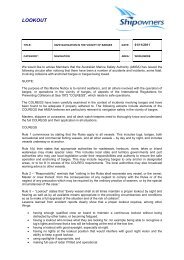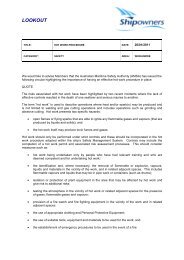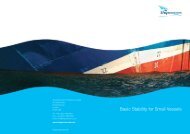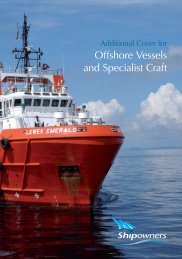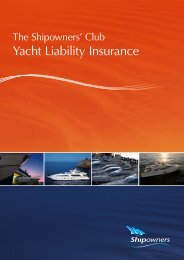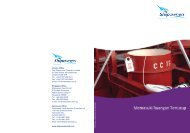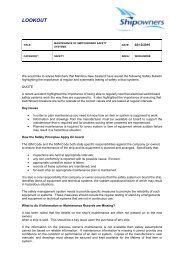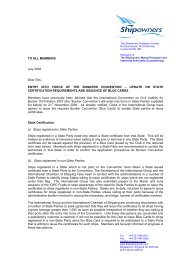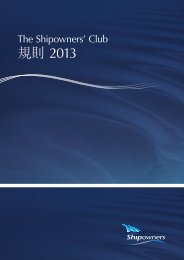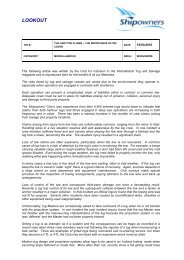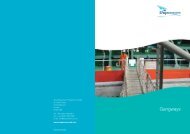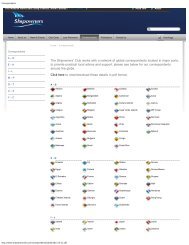Enclosed Space Entry - Shipowners
Enclosed Space Entry - Shipowners
Enclosed Space Entry - Shipowners
You also want an ePaper? Increase the reach of your titles
YUMPU automatically turns print PDFs into web optimized ePapers that Google loves.
Introduction<br />
The Club has recently experienced a number of claims where people have sadly lost their<br />
lives due to a direct failure to follow correct procedures for enclosed space entry. For the<br />
cases featured within this booklet (Appendix 1) it is important to highlight that the people<br />
involved were qualified and experienced in making enclosed space entries and therefore<br />
trained in the associated dangers, which unfortunately in many circumstances is not the case.<br />
<strong>Enclosed</strong> and confined spaces include, but are not limited to cargo holds, tanks (including<br />
ballast, fore and aft peaks, fresh water, slop / waste and bunker), void spaces, pump rooms,<br />
cofferdams, duct keels, pipe tunnels, main engines, chain lockers and any other spaces<br />
which may normally be kept closed or sealed. This is also relevant to spaces that are not<br />
regularly worked in or have a restricted air flow and hence are not subject to continuous<br />
ventilation.<br />
When seeing a colleague collapsed within an enclosed space it is a natural impulsive reaction<br />
to rush in and assist. Unfortunately this is one of the main causes of fatalities as over 50% of<br />
the workers who die in confined spaces are attempting to rescue other workers who have<br />
found themselves in difficulty. Although this is not the case in the included examples, it is a<br />
common factor and it should be borne in mind that if the correct procedures are followed and<br />
the relevant safety equipment prepared prior to carrying out the entry, then these deaths could<br />
have been avoided.<br />
It is essential to remember that when faced with such a serious dilemma, it is often difficult to<br />
think rationally. Therefore correct preparation resulting from a thorough risk assessment and<br />
evaluation enables the shipboard emergency contingency plans to be implemented in an<br />
expedient fashion.<br />
However, prevention is better than cure. To reduce the possibility of an incident,<br />
notwithstanding the type of vessel or the relevance of the ISM Code, written procedures for<br />
entry into enclosed spaces should be established, therefore giving all persons making an<br />
enclosed space entry instructions to adhere to. Once these procedures have been<br />
implemented, no entries are to be undertaken without compliance.<br />
2


